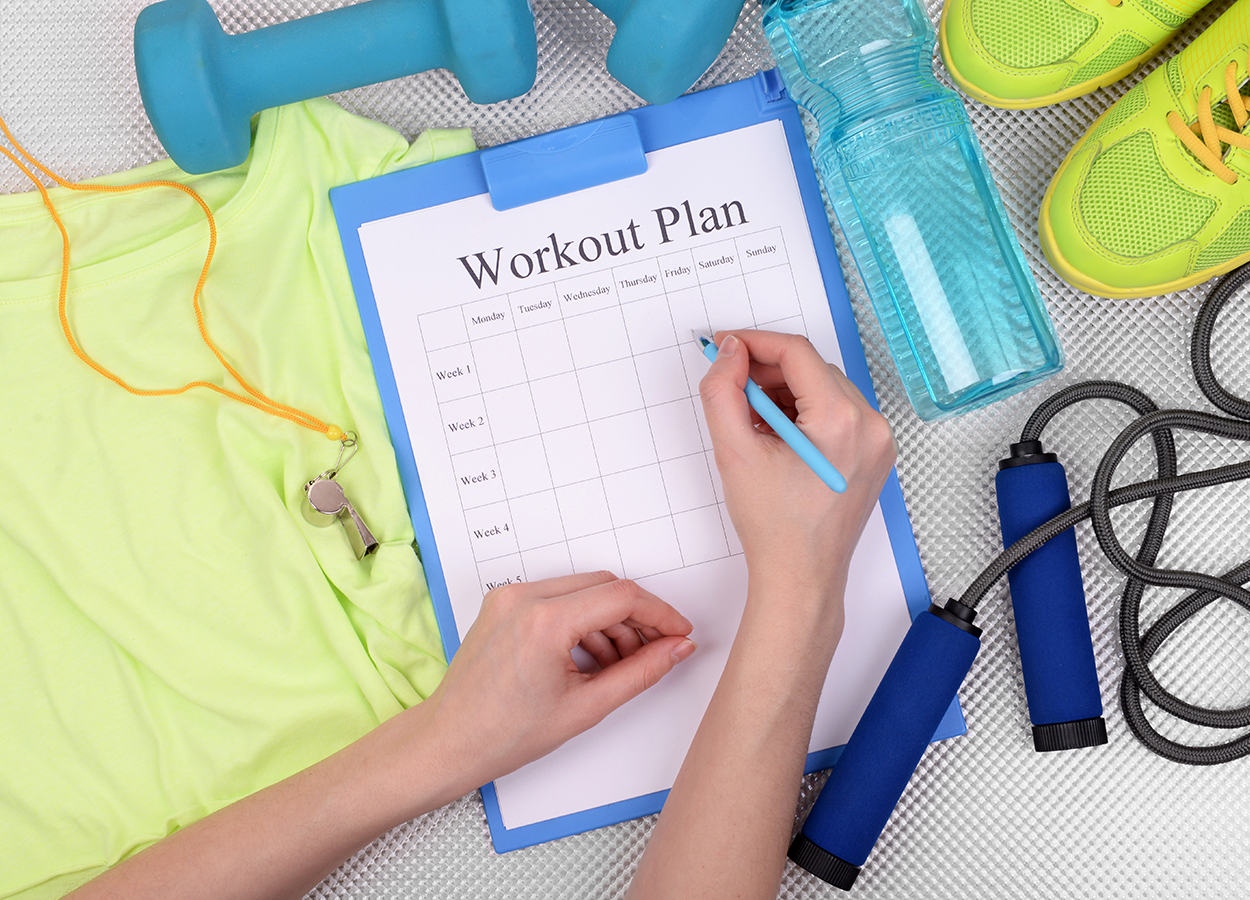Table of Contents |
Over these lessons on physical activity, you’ve learned there are a variety of ways to get moving and many options for meeting the Physical Activity Guidelines and achieving fitness-related goals. While everyone benefits from minimizing sedentary time and making physical activity a regular part of each day, this can look quite different from person to person. The following factors are ones to consider in having an exercise plan that is well-suited for you.
Considering what you want to achieve or maintain through physical activity ensures that you have an exercise plan that is personally meaningful to what you value. In the lesson titled “Wellness Assessment,” you learned about setting goals with the SMART framework. Consider if your main goal is something like weight loss or muscle gain, reaching a milestone like a certain amount of weight lifted or a certain distance run, or a goal of progression or consistency like working up to the Physical Activity Guideline recommendations.
While people can exercise consistently and successfully without a defined goal, goals are motivating in the following ways (American Council on Exercise, 2019):
It’s important to consider what resources you currently have available to you in personalizing your exercise plan and setting SMART goals. First, consider what equipment and environment are available to you. If you have a goal to build maximal strength and hypertrophy but do not have access to a fitness facility or any type of resistance equipment, your goal will be less achievable and realistic since you have only your body weight to work with. You may need to revise your goal based on what you have available, such as being able to complete a certain number of repetitions of a bodyweight movement.
Also, consider what resources are available to track your progress toward your goal. If you have a goal to lose a certain percentage of body fat, but don’t have a way to measure your body composition, you may start to lose motivation since you can’t accurately assess your progress. It may be more helpful to set a process goal (which you learned about in the lesson titled “Wellness Assessment”), such as accumulating a certain amount of exercise on a weekly basis.

Consider what time you have available to devote to exercise and how it will fit into your existing schedule. It may not be realistic for someone with a full-time job, schoolwork, and a family to dedicate hours each day to exercise. The types of time-efficient workouts you’ve learned about, like circuit training or high-intensity interval training, maybe a better fit for someone with a packed schedule. Those who are time-crunched may also need to consider how to fit short, portable exercise bouts into their routine throughout the day, rather than taking travel time to go to and from a gym or other fitness facility.
There is no single “best” exercise or way to organize and choose exercises. However, every exercise in a person’s program, and the progression of that program, should logically be based on their current fitness level, experience, and skill (McCall, 2014). People who are new to exercise and those with health conditions can especially benefit from seeking the guidance of a certified fitness professional (Garber et al., 2011).
The American College of Sports Medicine provides some example guidelines for progressing both cardiovascular exercise and resistance training exercises based on a person’s experience and using the FITT principles (Bushman, 2018). With the terms below, a beginner is someone with no prior experience or who has been sedentary for several years. Intermediate refers to someone who has approximately 6 months of consistent activity, and established or advanced refers to someone who has been training for years (American College of Sports Medicine, 2009).
| Cardiovascular Exercise – Walking Program Example | |
|---|---|
| Beginner |
Begin by walking a total of 20 minutes each day (which can be 10 minutes twice a day) at an RPE of 3–4 to accumulate a weekly total of 60 minutes. Once this is reached, add 10 minutes to the weekly total until 100 minutes is reached. Maintain the duration and increase intensity over the next weeks to an RPE of 5–6. Maintain this time and intensity and continue to add 10–15 minutes each week until consistently doing 150 minutes weekly. |
| Intermediate | Accumulate a weekly total of 150 minutes by walking at an RPE of 5–6 for 30–60 minutes, 3–5 days a week. Progress either by continuing to increase exercise duration beyond 150 minutes or start to introduce bouts of vigorous-intensity exercise (RPE of 7–8), such as walk-jog intervals. |
| Established | Walk at an RPE of 5–6 for a weekly total of 200–300 minutes or increase to vigorous intensity (RPE of 7–8) for a weekly total of 100–150 minutes; or combine moderate and vigorous intensities over the week. |
| Resistance Training Exercise Program Example | |
|---|---|
| Beginner | Perform a total of 6 exercises for 1–2 sets, for 8–12 reps, 2–3 days a week. |
| Intermediate | Perform a total of 10 exercises for 2 sets, for 8–12 reps, for 2–3 days a week. |
| Advanced | Perform 10 exercises 2–3 times a week for larger muscle groups (hips, legs, chest, back), and 5 exercises twice a week for smaller muscle groups (abdominals, shoulders, biceps, triceps) for 8–12 reps. Different exercises can be performed on different days and a given muscle group should receive at least 48 hours of rest before working it again. |
IN CONTEXT
The information in the table above provides general guidelines based on improving general fitness. As you learned in the lessons “Cardiovascular Training Principles” and “Resistance Training Principles”, someone with a specific goal—such as running a faster mile or improving the weight they can lift for a 1-rep max—would need to use the FITT principle in a more targeted way. For example, someone with a goal of maximal strength would do 6 repetitions or less because their intensity is higher, rather than the 8–12 repetitions listed in the table.
Given the health benefits of regular physical activity, we might have to ask why many Americans are not active at recommended levels. Many technological advances and conveniences have made our lives easier and more sedentary. In addition, many personal variables, including physiological, behavioral, and psychological factors, may affect our plans to become more physically active. Understanding common barriers to physical activity and creating strategies to overcome them can help with regular consistency.

| Barrier | Strategies |
|---|---|
| Lack of time |
Monitor your daily activities for one week. Identify at least three 30-minute potential time slots. For example, perhaps there are times you spend watching TV or using your phone that could be pared down to accommodate exercise. Add physical activity to your daily routine, such as walking or biking to work or errands, walking the dog if you have one, exercising while watching TV, and others. Choose activities that require minimal time. Walking can be done almost anywhere and does not need an extensive warm-up. |
| Lack of motivation |
Invite friends and family members to exercise with you. Plan social activities involving physical activity, such as hikes or recreational games. Develop new friendships with physically active people through joining groups or clubs centered around activity. Join an exercise group or class at a fitness center or in your community. |
| Lack of energy |
Schedule physical activity ahead of time for times of day that you typically feel most energetic. Convince yourself that if you give it a chance, physical activity will increase your energy level—then try it. |
| Fear of injury or lack of skill |
Learn how to exercise appropriately considering your age, fitness level, skill level, and health status. Consider seeking guidance from a certified fitness professional, such as a personal trainer. Select activities that do not require skill and are low risk, such as walking. Attend group fitness classes to develop new skills and learn proper form and technique to prevent injury. |
| Weather conditions or travel | Have a set of enjoyable activities that are always available regardless of weather or being away from home, such as a bodyweight circuit you can do inside, stair climbing, mall walking, or routines online or through an app. |
| Lack of resources | Identify inexpensive, convenient resources available in your community. Examples include park and recreation programs, walking trails, local fitness events, and more. |
| Family obligations |
Exercise with your family if possible—walk together, play active games, or use an online resource or app. For those with children and obligations in caring for them, consider fitting in exercise when kids are not around or awake yet, such as in the early morning hours or when kids are at school. |
Source: THIS TUTORIAL WAS CURATED AND/OR AUTHORED BY Anna Caggiano WITH CONTENT ADAPTED FROM “WELLNESS” BY EXTENDED LEARNING INSTITUTE (ELI) AT NOVA. ACCESS FOR FREE AT oer commons. LICENSING: CREATIVE COMMONS ATTRIBUTION 4.0 INTERNATIONAL.
REFERENCES
American College of Sports Medicine (2009). American College of Sports Medicine position stand. Progression models in resistance training for healthy adults. Medicine and Science in Sports and Exercise, 41(3), 687–708. doi.org/10.1249/MSS.0b013e3181915670
American Council on Exercise (2019). The professional’s guide to health and wellness coaching. ACE. ISBN: 978-1-890720-71-1
Bushman, B. A. (2018). Developing the P (for Progression) in a FITT-VP Exercise Prescription. ACSM's Health & Fitness Journal, 22(3), 6-9. doi.org/10.1249/FIT.0000000000000378
Garber, C. E., Blissmer, B., Deschenes, M. R., Franklin, B. A., Lamonte, M. J., Lee, I. M., ... & Swain, D. P. (2011). Quantity and quality of exercise for developing and maintaining cardiorespiratory, musculoskeletal, and neuromotor fitness in apparently healthy adults: guidance for prescribing exercise. Medicine & Science in Sports & Exercise, 43(7), 1334-1359. doi.org/10.1249/MSS.0b013e318213fefb
McCall, P. (2014). How to select the right exercises for your clients. American Council on Exercise. www.acefitness.org/resources/pros/expert-articles/4921/how-to-select-the-right-exercises-for-your-clients/